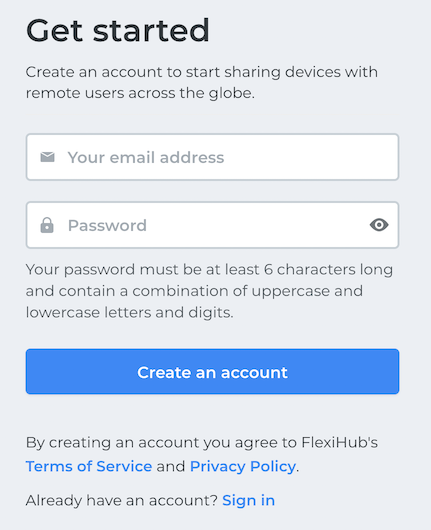
FlexiHub Team uses cookies to personalize your experience on our website. By continuing to use this site, you agree to our cookie policy. Click here to learn more.

FlexiHub
As you may already know, there is a way to set up your Raspberry Pi as a USB-over-Ethernet server. Well, actually, there is not one, but three roads you can take here: an easy path with the hundred-per-cent efficient paid app or a bumpy ride with an open-source solution and its fiddly config process. And we’re about to take a look at all of them.
That’s it!
From that point on, the shared USB device will be remotely accessible from all computers with FlexiHub installed and an internet connection, regardless of the operating systems or physical distances involved.
Universal Solution:
Redirection USB Server: FlexiHub’s unique Redirection USB Server allows the app to work through all firewalls without requiring public IP addresses.
Peripheral Sharing: You can share a USB hub so that any peripheral connected to its USB ports becomes instantly available for remote connections with no additional configuration needed.
Enhanced Performance:
Traffic Compression: FlexiHub offers an optional traffic compression feature, which is particularly useful for bandwidth-sensitive USB devices like USB printers or web cameras. This means you don't need a high-speed 1 Gbps internet connection to make them work efficiently.
Security:
SSL Encryption: FlexiHub provides bulletproof 2048-bit SSL encryption to completely prevent unwanted access to your security cameras, USB dongles, or any data transmitted through FlexiHub.
In principle, this method is similar to the one we've just described, but through the agency of a different USB to Ethernet extension app. And given that this time we’ll be using an open-source solution that's still in development, the set-up process requirements are there for a decent level of technical competence to perform so if you don’t have any, don't be surprised if it won’t work on the first go. Anyway, if you are interested in embedded programming over a network, you will definitely give it a try.

Here are some more important points you need to consider before opting for this method:
sudo apt install usbip
sudo modprobe usbip_hostecho 'usbip_host' >> /etc/modules
lsusb command to view a list of all USB devices physically connected to your Raspberry Pi and remember (or write down) the 8-digit USB ID number of a device you’re going to share.
usbip list -p -l command to find out your device’s bus ID (use the USB ID number from a previous step to identify the right device on the list). Write down that number.
sudo usbip bind --busid=Nusbipd
Alternatively, you can create a systemd service:
vi /lib/systemd/system/usbipd.service
with the following definition (don’t forget to change the N for an actual USB ID number of your device):
[Unit]
Description=usbip host daemon
After=network.target
[Service]
Type=forking
ExecStart=/usr/sbin/usbipd -D
ExecStartPost=/bin/sh -c "/usr/sbin/usbip bind --$(/usr/sbin/usbip list -p -l | grep '#usbid=N#' | cut '-d#' -f1)"
ExecStop=/bin/sh -c "/usr/sbin/usbip unbind --$(/usr/sbin/usbip list -p -l | grep '#usbid=N#' | cut '-d#' -f1); killall usbipd"
[Install]
WantedBy=multi-user.target
And then you'll need to run these commands to start that service:
sudo systemctl --system daemon-reloadsudo systemctl enable usbipd.servicesudo systemctl start usbipd.serviceOk, now let's set up a client:
Note: The app does have a client for Windows, but it’s a flimsy beta version with no signed drivers or any support for Windows 10, thus not really worth mentioning.
1. To install the same app for sharing USB over IP in Ubuntu, execute these commands:
sudo -s
apt-get install linux-tools-generic -y
2. Enable the required module:
modprobe vhci-hcd
echo 'vhci-hcd' >> /etc/modules
Now, to connect the shared device to this machine, run the command:
sudo usbip attach -r 0.0.0.0
(type the actual IP address of your Raspberry Pi instead of 0.0.0.0)
Or you can create a systemd service:
vi /lib/systemd/system/usbip.service
With the definition (replace N with an actual USB ID number of your device and 0.0.0.0 with your Raspberry’s IP address):
[Unit]
Description=usbip client
After=network.target
[Service]
Type=oneshot
RemainAfterExit=yes
ExecStart=/bin/sh -c "/usr/lib/linux-tools/$(uname -r)/usbip attach -r 0.0.0.0 -b $(/usr/lib/linux-tools/$(uname -r)/usbip list -r 0.0.0.0 | grep 'N' | cut -d: -f1)"
ExecStop=/bin/sh -c "/usr/lib/linux-tools/$(uname -r)/usbip detach --port=$(/usr/lib/linux-tools/$(uname -r)/usbip port | grep '<Port in Use>' | sed -E 's/^Port ([0-9][0-9]).*/\1/')"
[Install]
WantedBy=multi-user.target
Save, and then run these commands to start the service:
sudo systemctl --system daemon-reload
sudo systemctl enable usbip.service
sudo systemctl start usbip.service
After that, you should be able to access the shared device remotely. If not, try all the steps again from the very beginning.
Important! If you unplug a USB device from the Raspberry Pi while it’s shared by this method it may result in permanent data loss. Turn off your Raspberry first (after it’s off, you can also disconnect its AC adapter for extra precautions).

Building a wireless USB over IP hub with a Raspberry Pi is a relatively simple exercise if you have the following two components.
VirtualHere enables the sharing of network-attached USB devices. It’s a solution that lets you connect remote USB devices and use them as if they were directly attached to your local machine. A VirtualHere server allows you to remotely access USB devices like scanners, printers, and webcams from any location on your network.
You can create a hub to support USB over IP using Raspberry Pi with the following steps.
$ wget https://www.virtualhere.com/sites/default/files/usbserver/vhusbdarm$ chmod +x vhusbdarm$ sudo ./vhusbdarm -b
See the available options by executing this command:
$ ./vhusbdarm -hAny type of USB device can be connected over the network with this method. Meaning that wireless embedded programming is possible without any additional steps. The number of open ports presents the only limitation on the number of devices you can connect. You can also add a physical USB hub to provide more USB ports and enable you to connect additional devices.
|
|
|
| ||||||
|---|---|---|---|---|---|---|---|---|
| Proxi-server |
Redirection Server • no need for external IP • multi-network communication • works through the Firewall |
N/A | N/A | |||||
| ||||||||
| Firmware for microcontrollers | Raspberry (upon request) | N/A | Raspberry | |||||
| Security |
Login tokens for safe account sharing
Lock for device access control
|
N/A | N/A | |||||
| Encryption | 2048-bit SSL | SSL, not from GUI | SSL, for program | |||||
| Enhanced stability | Keep connection active option | N/A | N/A |
The decision of which method to adopt from the ones described in this article is entirely yours. However, it might be wiser to opt for a user-friendly tool with a track record of effectiveness rather than risking potential downtime, which could lead to considerable stress, time loss, and financial expenses. Choose what works best for you.
